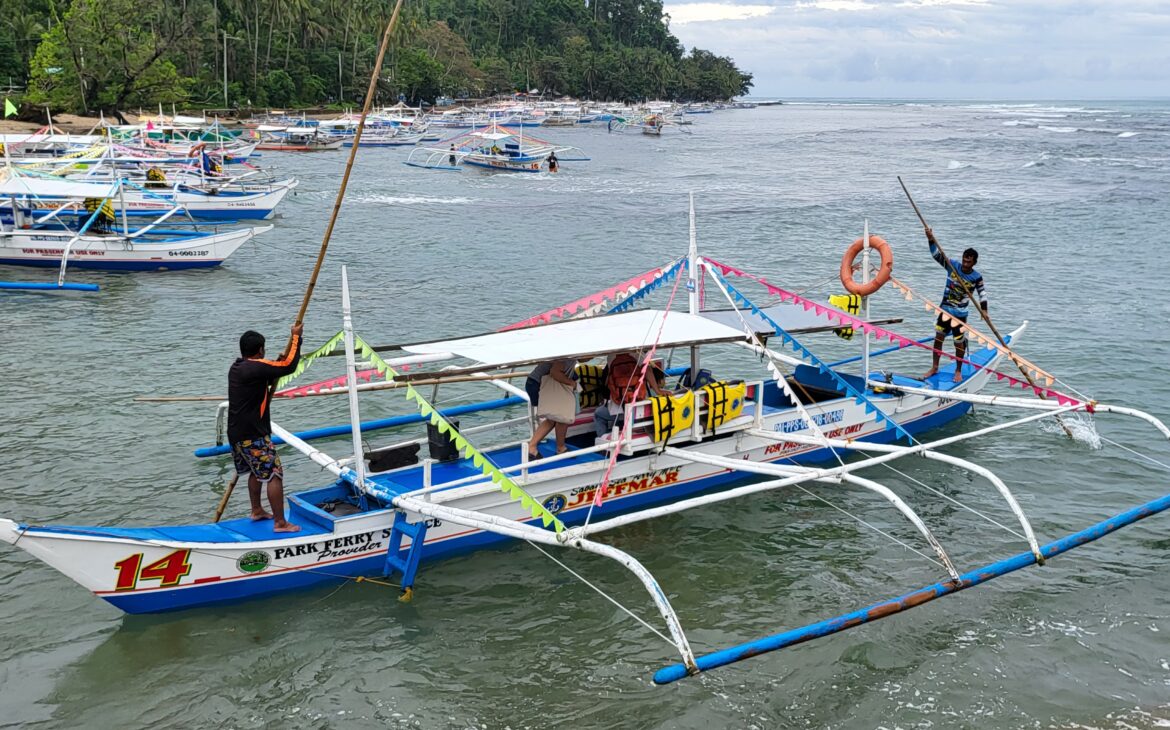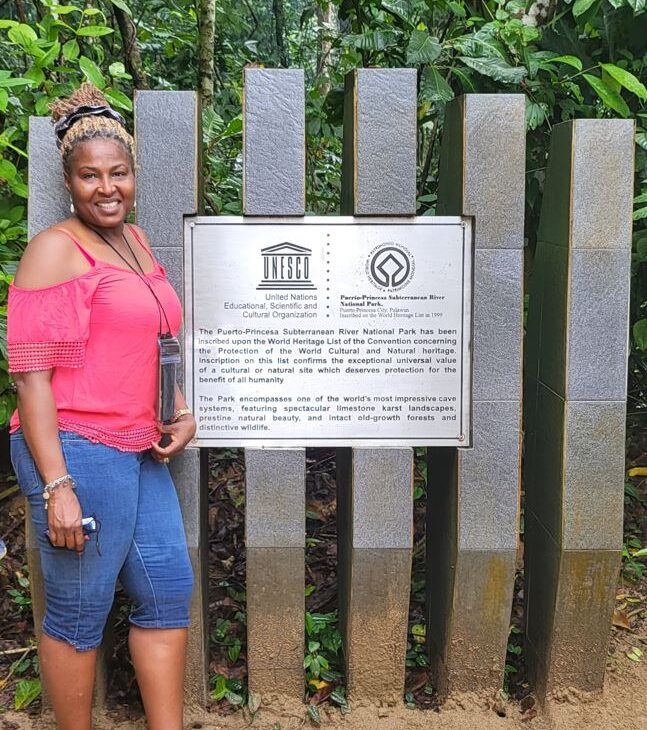Standing here, my left leg is bathed by the waters of the West Philippine’s Sea while the right, a step up, held me in a pose ready for the picture that is being taken of me. Behind me, in the swelling waves of the water below, are the brightly painted kayaks known locally here as the Bangka. In front is a large concrete platform known as the boat terminal. it is here that all sea farers commence or disembark from their journey.
This is Sabang, a seashore town, the gateway to the Puerto Princesa Subterranean River National Park. Though the park is connected to the town by land, for preservation purposes it is rendered inaccessible except by sea and like all other visitors, we are about to commence the last leg of our journey from the terminal.
Sabang is not much different from many other towns on the Palawan Island. It is entombed in a way by majestic mountains of various formations and shapes. But that is where the similarities end. What makes Sabang different is its stretch if gorgeous white sand beach and the pristine nature of the forests that thrive on the sorrounding mountains. Of course, there is also the Santuario de San Jose Marello standing tall with its unique white walled Catholic architecture in the town centre.
Years ago Sabang must well have existed to serve the fishing communities and hauling ashore for the inland markets the fishes of the sea. Not anymore. Tourism has driven such activities to second place, if they exist at all. Today’s Sabang is all about tour operators and the clients they convey in and out of the town almost endlessly.

Earlier, alighting from the bus, we had given our tour guide the park fees. These are mandatory for anyone proceeding to the park. He approaches closely followed by the other members of our group and we are all soon helped into one of the Bangka, all the while trying to keep dry from the continual assault of the waves that break with such force that the waters get as high as the boat terminal’s platform.
The Bangka, is like no other boat. Narrow and carved out of wood, presumably harvested from the sorrounding forrest, it is stabilised on both sides by Bamboo for good reason. Without the two horizontal lengths of bamboo on boat sides of the Bangka, it will easily capsize in the stormy waters of the sea where it operates. For protection from the rains that fall intermittently in this area, the Bangka has a covering tailing off in a triangular fashion over the two sets of benches that lie in its mid-section upon which we sit.
Having been pushed a little from the shore, the Bangka’s engine roars to life and we are on our way. Ahead of us are other Bangka’s who are moving ahead, tossed up and down in the horizon, like little butterflies in a the wind.
On our right are the eternal mountains bearing the marks of their age long battle of resistance with the sea. The mountains stand firmly pronouncing Job 38:11 to the sea – hitherto shalt thou come, but no further and here shall thy proud waves be stayed. All falling on the deaf ears of the stubborn waters of the West Philippines Sea which remain disobedient. The mountain tops are densely covered with lush thick green forest, providing sanctuary to many animals that one can only imagine.
On our left is the open sea. Looking at the vast water that stretches as far as the eyes could see, one becomes humbled in quickly appreciating how insignificant man is to nature. In this moment I quickly understands why the Psalmist had to ask God – what is man, that thou art mindful of him? If anything is to go wrong, in a twinkle of an eye we would disappear leaving no trace apart from the Bangka that will be floating unoccupied.
As we approached the landing point, we take a right turn to enter the bay. Here, the rocky mountain juts out to the sea in a V formation as if it is made out of two fingers on one’s hand. V signalling Victory or Veni, Vidi, Vici, any of which will be apt given the journey we have made.

Landing is akin to departure, except the waves are higher. The engine of the boat is shut-off and we are left to depend on the skills of the captain and his mate to get us ashore without grounding the boat. The mate throws down a short wooden ladder, jumps into the sea and holds tightly to the anchor rope while at the same time helping us, one at a time, to descend into the waves on the little steps of the ladder.
We are not alone, all around are the other Bangka’s now floating a little distance from shore having dropped their passengers earlier.
As we step on the shore of this environment, unspoiled by man, one can only imagine how inviting the same land must have been to the first Spanish sailors that set their eyes on it.
The tall Coconut trees with their palms swaying to the dictates of the wind, the white sands contrasting perfectly with the sorrounding brownish green rocks and the thick dark green rain forest that is present everywhere one looks provide a view incomparable to no where else.

We take off our life jackets and soon have our cameras out from their plastic containers, taking pictures. Our guide calls out as it is becoming obvious we are not in a hurry to leave the shore. It is going to be a short walk of about 400 metres through the cleared bush path at the end of which we will arrive at the entrance to the Cave.
Prior to departure, we have been briefed that we should consider ourselves as guests of the monkeys, as the area we are is their land. Truly as told, we can see them around – climbing tree trunks, walking in the folliage and even by the cave entrance. We need to exercise caution lest they do the grab and run on us, as no one will climb the trees to chase after a monkey.
At the river side, we get assigned seats in the kayak while our guide gives a briefing about the underground terrain we are entering and the expectations required from us as tourists to keep everyone safe. We are handed some electronic sets, with earpieces, containing pre-recorded messages to point out the important features of this underground world.
The five of us, along with the boat captain, start the journey into the thick darkness of the cave. Illumination is deliberately lacking to protect the sleeping bats hanging from everywhere on the cave ceiling.
We are soon enveloped by thick darkness and sorrounded by many creatures which can see us but we cannot see. As we are shown the Stalactites and Stalagmites, the science behind the formation of the caves, lectured on how long it takes for water to travel from ground surface to forming as a drop at the roof of the cave, different cave structures, the depth of the river at different points and the rich composition of the feaces of bats, the only thing in my mind was fear.
Fear? Fear that the cave may collapse and we get entombed. Fear that a creature may suddenly emerge from the water beneath us or the thick darkness around us. Fear of the bats, afterall I grew up being informed that bat suckers.
Our trip in and out of the cavern takes roughly 45minutes and all through we are paddled by hand, without any mechanical aid because of the air and noise pollution they will cause. Even our boat is flat bottomed so as to have the least impact on the marine life beneath us. As we approach the exit of the cave and one can see the light streams coming in, I let out a long sigh of relief. Thank goodness, we are back to an environment I am familiar with. I had stared death in the eyes and lived.
Out of the cave and back on solid ground, my co-tourists are full of great excitement. They have only superlative words to describe the experience and would love to have another go.
We make our way to the beach and into the Bangka which takes us back to the shores of Sabang. The tour fee includes lunch and we are thankful it does not because on arriving back at Sabang we are all hungry. We get ushered into the tarpaulin covered dinning area of one of the many restaurants close to the beach. It is a buffet lunch of Filipino cuisine so it is not surprising that rice features prominently as a base. Being by the sea also means a variety of fish sauces and seafood is available. Tropical fruits as Mangoes, Coconuts, Oranges, Bananas are available as well. We have a sumptuous lunch and bid our farewell to Sabang.
As the bus starts its two-hour trip back to Puerto Princesa, we are tired, worn out from the adventure and sleep off.
It has been another day in the Philippines.

This is another excellent one from you Seun.
More blessings
Ore, thanks for your comments. Really appreciate it